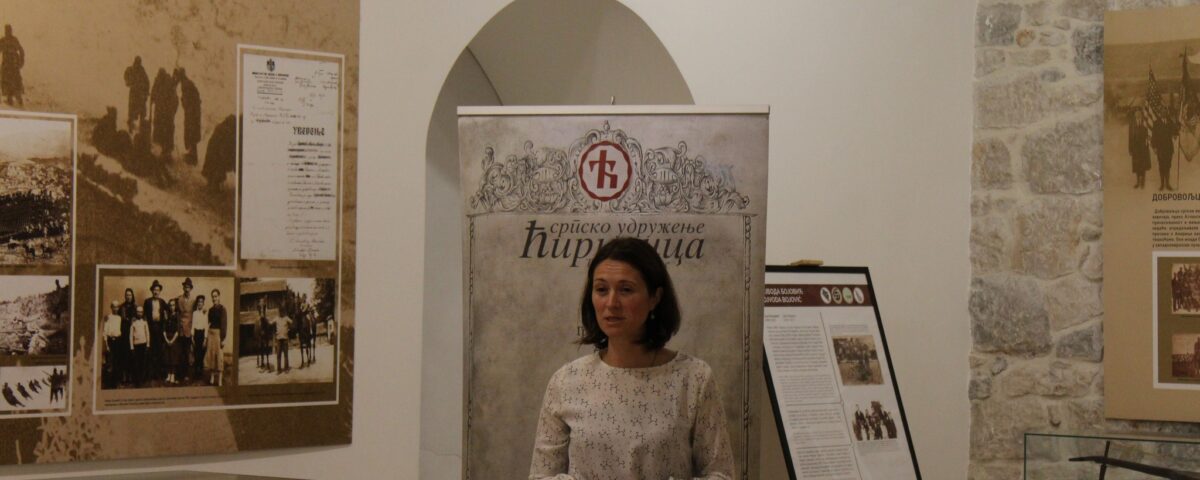Предавање ,,Улога Дубровника и Херцеговине у нормирању српског језика“ Душана Пејића / А lecture „The role of Dubrovnik and Herzegovina in the standardization of the Serbian language“ by Dušan Pejić

Изложба ,,Србија, земља фресака“ / Exhibition
7. новембар 2022.
Музејска радионица / Museum′s woorkshop
7. новембар 2022.Предавање ,,Улога Дубровника и Херцеговине у нормирању српског језика“ Душана Пејића / А lecture „The role of Dubrovnik and Herzegovina in the standardization of the Serbian language“ by Dušan Pejić

У суботу, 5. новембра, у Музеју Херцеговине у Требињу, у организацији Удружења ,, Ћирилица“ одржано је предавање ,,Улога Дубровника и Херцеговине у нормирању српског језика“ Душана Пејића, асистента на Катедри за србистику Филозофског факултета Универзитета у Источном Сарајеву. Предавање је организовано за учеснике Седме школе палеографије које организује Удружење ,,Ћирилица“
Весна Андрић је поздравила присутне и навела значај Удружења ,,Ћирилица“ за промоцију и заштиту ћириличног писма, не само у Требињу већ и у Републици Српској.
У име Музеја Херцеговине у Требињу, присутне је поздравио Симо Радић, музејски педагог, који је присутнима предочио значај Требиња у средњем вијеку, као изузетно важног културног, политичког и привредног центра средњовјековне српске државе. Такође, поменута су и скорија археолошка истраживања у простору Музеја Херцеговине у Требињу гдје се дошло до открића зидина, које су биле дио дворског комплекса који се у средњем вијеку налазио на мјесту музејске зграде.
Душан Пејић је своје предавање искористио да истакне значај средњовјековних палеографских споменика на подручју Херцеговине, јер је то област гдје се и налази највећи број натписа. Такође, упоређивао је језик Херцеговине и Дубровника, са посебним освртом на сличности у говору ова два краја, као и на елементе које је Вук Стефановић Караџић из тих говора усвојио у основу књижевног српског језика.
On Saturday, November 5thin the Museum of Herzegovina in Trebinje, organized by the „Cirilica“ Association, a lecture „The role of Dubrovnik and Herzegovina in the standardization of the Serbian language“ by Dušan Pejić, assistant at the Department of Serbian Studies at the Faculty of Philosophy of the University of East Sarajevo, was held. The lecture was organized for the participants of the Seventh School of Paleography, organized by the „Ćirilica“ Association.
Vesna Andrić greeted those present and stated the importance of the „Cyrillic“ Association for the promotion and protection of the Cyrillic alphabet, not only in Trebinje but also in the Republic of Srpska.
On behalf of the Museum of Herzegovina in Trebinje, the attendees were greeted by Simo Radić, museum pedagogue, who presented the importance of Trebinje in the Middle Ages, as an extremely important cultural, political and economic center of the medieval Serbian state. Also, recent archaeological research in the area of the Museum of Herzegovina in Trebinje was mentioned, where the walls were discovered, which were part of the palace complex that was located on the site of the museum building in the Middle Ages.
Dušan Pejić used his lecture to highlight the importance of medieval palaeographic monuments in the area of Herzegovina, because this is the area where the largest number of inscriptions are found. He also compared the language of Herzegovina and Dubrovnik, with special reference to the similarities in the speech of these two regions, as well as to the elements that Vuk Stefanović Karadžić adopted from those speeches into the basis of the literary Serbian language.



